I am trying to create a grid like in the "Wombat" game while keeping a background for it.
I am creating a bejeweled like game where-in I'm planning on having a menu on the left side and a little ''Adventure'' style thing running in the top, a lot like the game "10,000,000".
My problem is that i cannot find a way to create both of these things. My plan so far is to create a subclass on my primary world so that i can just load the actors in the grid for the bejeweled effect and then have separate worlds for each instance in the game.
My idea is to create a world using the 'super(600, 400, 1);' command followed by a 'super(8, 8, 60); ' command, though i can't figure out how to properly implement this.




 Ok, so I hit a bump.. my game keeps saying this "at Main_Control.<init>(Main_Control.java:30)" and I simply cannot figure out why, so far I've copied your PIP actor to the letter and I started putting in one of my PIP worlds, the error occurs when I try to compile this script.
Ok, so I hit a bump.. my game keeps saying this "at Main_Control.<init>(Main_Control.java:30)" and I simply cannot figure out why, so far I've copied your PIP actor to the letter and I started putting in one of my PIP worlds, the error occurs when I try to compile this script.